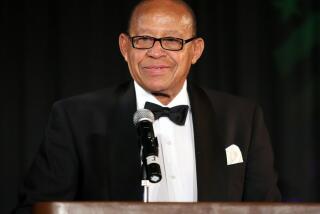Jack Nelson dies at 80; Pulitzer Prize-winning reporter helped raise L.A. Times to national prominence
Jack Nelson, a Pulitzer Prize-winning investigative reporter, author and longtime Washington bureau chief for the Los Angeles Times, whose hard-nosed coverage of the civil rights movement in the 1960s and the Watergate scandal in the 1970s helped establish the paper’s national reputation, has died. He was 80.
Nelson died of pancreatic cancer Wednesday at his home in Bethesda, Md., according to his wife, journalist Barbara Matusow.
The veteran newsman was recruited from the Atlanta Constitution in 1965 as part of publisher Otis Chandler’s effort to transform The Times into one of the country’s foremost dailies. An aggressive reporter who had exposed abuses at Georgia’s biggest mental institution, Nelson went on to break major stories on the civil rights movement for The Times, particularly in his coverage of the shooting of civil rights worker Viola Liuzzo and the slaying of three black students in South Carolina in what is known as the Orangeburg Massacre.
As the Watergate scandal unfolded during President Nixon’s reelection drive, Nelson scored an exclusive interview with Alfred C. Baldwin III, an ex-FBI agent hired by White House operatives, who witnessed the break-in at Democratic National Committee headquarters on June 17, 1972. The stories resulting from Nelson’s interview with Baldwin were the first to link the burglary “right to the heart of the Nixon reelection campaign,” David Halberstam wrote in his 1979 media history, “The Powers That Be.”
Named in 1975 to lead the Washington bureau, Nelson oversaw its evolution over the next 21 years into what Gene Roberts Jr., former managing editor of the New York Times and a onetime rival of Nelson’s on the civil rights beat, called “arguably one of the finest bureaus ever in Washington.”
‘Distinguished career’
“Just his work at the Constitution would be a distinguished career for most journalists,” Roberts said. “Then add that he was one of the most effective reporters in the civil rights era, all before you even get to him being bureau chief in Washington.
“All in all, I would say he was one of the most important journalists of the 20th century.”
A slender man with a Southerner’s easy manner, Nelson was born Oct. 11, 1929, in Talladega, Ala., where his father ran a fruit store during the Depression. The younger Nelson drew Talladega’s citizens into the shop with vaudevillian humor (“Lady, you dropped your handkerchief,” pause, “in St. Louis yesterday”), displaying a talent for connecting with people that would bolster his later success as a reporter.
He said that “being a reporter is a lot like being a good salesman,” said Richard T. Cooper, a longtime friend and a Washington bureau editor for Tribune Co., which owns The Times. “You had to be able to sell yourself to people, convince them that they should answer your question or show you the records” or buy a bag of fruit from your father’s store.
Nelson and his family moved to Georgia and eventually to Biloxi, Miss., where he graduated from Notre Dame High School in 1947. Without stopping for college (he later studied briefly at Georgia State College), the teenager launched his career by answering an ad for a job at the Biloxi Daily Herald. He was soon called “Scoop” for vigorous reporting on corrupt officials and gambling payoffs.
In 1952, after a stint writing news releases for the Army, he joined the staff of the Atlanta Constitution. In a series of articles on Georgia’s Milledgeville Central State Hospital for the mentally ill, he exposed an array of abuses, including experimental treatments of patients without consent, alcohol and drug abuse by on-duty doctors, and nurses who were allowed to perform major surgery. As a result of his reporting, the hospital was overhauled and Nelson won a Pulitzer Prize for local reporting in 1960.
When he joined the Los Angeles Times five years later, the civil rights movement had been underway for a decade, but The Times “had no coverage of the South. We were doing terribly covering the South,” recalled former Managing Editor George Cotliar, who was national news editor in the 1960s. So the paper hired Nelson to close the gap.
He opened The Times’ Atlanta bureau and immediately began covering the voting rights demonstrations in Selma, Ala., where on “Bloody Sunday,” March 7, 1965, state troopers and local lawmen clubbed and tear-gassed 600 civil rights marchers en route to Montgomery. “He just annihilated every other paper. He was ahead of everyone on everything,” said Cotliar, who called Nelson “the toughest, hardest-charging, finest reporter I’ve known in my 40 years in the business.”
Nelson’s stories quoted sources critical of then-Gov. George Wallace’s failure to protect the marchers. According to Bill Kovach, who covered the protests for the Nashville Tennessean and later was editor of the Atlanta Journal-Constitution, the governor singled out Nelson for ridicule, pointing out to white audiences “outsiders like Jack Nelson there of the L.A. Times -- that one there with the burr haircut -- trying to tell us Alabamians how to run our state.”
In 1970 Nelson experienced the wrath of FBI Director J. Edgar Hoover. The reporter, after conducting an eight-month investigation, wrote a story about how the agency and police in Meridian, Miss., shot two Ku Klux Klan members in a sting operation bankrolled by the local Jewish community. One of the Klan members, a woman, died in the ambush.
Hoover attempted to suppress the story by smearing Nelson as a drunk, which he was not. (“What they didn’t realize,” the reporter later quipped to Hoover biographer Curt Gentry, “is that you can’t ruin a newspaperman by branding him a drunk.”) By defying Hoover, he lost his FBI sources but wrote the article, which ran on Page 1.
Twenty years later, Nelson dusted off his notes from the story and wrote “Terror in the Night” (1993), a book that described the shooting in the context of the Klan’s shift from battling blacks to targeting Jews, whom it had begun to regard as the real leaders of the civil rights movement.
Nelson wrote “The Censors and the Schools” (1963) with Roberts; “The Orangeburg Massacre” (1970) with Jack Bass; “The FBI and the Berrigans” (1972) with Ronald J. Ostrow; and “High School Journalism in America” (1974).
In 1972, two years after he joined the Washington bureau, Nelson was, according to Halberstam, “one of the two or three best-known and most respected investigative reporters in Washington.” But, like most of the Washington press corps, he was frustrated by the Washington Post’s dominance of the Watergate break-in story.
The scales briefly tipped in favor of The Times when Nelson received a tip from colleague Ostrow that there was an eyewitness to the Watergate burglary. Nelson began knocking on doors in Connecticut, where Baldwin, the ex-FBI man, and his lawyers lived.
“He was a good reporter because he was always prepared and plain didn’t take ‘no’ for an answer,” said William F. Thomas, The Times’ editor from 1971 to 1989. “That was his biggest asset . . . . Anybody who looked at the set of his jaw knew they were in for something.”
After much back and forth, Nelson was granted an interview with Baldwin, who unwound a fascinating tale of his recruitment by ex-CIA man James McCord, his encounters with G. Gordon Liddy and Howard Hunt, and his job monitoring wiretaps on Democratic phones and delivering sealed tapes to Nixon’s reelection committee. Baldwin also told of watching from across the street as the burglary at the Watergate complex unfolded and spying Hunt slip away as the police closed in.
When word of Nelson’s scoop leaked out, federal prosecutors threatened to revoke Baldwin’s immunity, and Baldwin’s lawyers pleaded with Nelson to drop the story. Federal Judge John J. Sirica issued a gag order, and then-Washington bureau chief John Lawrence spent a few hours in detention after The Times refused to turn over the tapes of the Baldwin interview.
The Times took the case to the U.S. Supreme Court, which ruled in favor of the paper. On Oct. 5, 1972, the paper ran a Page 1 news story by Nelson and Ostrow detailing Baldwin’s revelations, as well as a first-person account by Baldwin as told to Nelson.
‘A great victory’
Halberstam called the Baldwin story “perhaps the most important Watergate story so far, because it was so tangible, it had an eyewitness, and it brought Watergate to the very door of the White House. . . . It was a great victory for the Los Angeles Times.”
Nelson became chief of the bureau in 1975, when it had 15 reporters and three editors. By 1980 the bureau was described by Time magazine as “one of the two or three best” in Washington. By 1996, when Nelson turned the job over to White House correspondent Doyle McManus, it was one of the biggest, as well, with 36 reporters and seven editors.
Known for backing his staff and pushing hard on investigative stories, Nelson made The Times a must-read for Washington’s power elite. “The depth and scope of the Washington bureau under Jack was very impressive,” said Roberts, the former New York Times managing editor. “We certainly paid attention to what the Los Angeles Times was doing in its Washington bureau.”
In a town consumed by politics, Nelson was a well-connected insider who held a coveted seat as a regular commentator on public television’s “Washington Week in Review.” He brought presidents, senators and members of the House and Cabinet to The Times’ offices for regular breakfast sessions with reporters that were broadcast on C-SPAN. “That raised our profile tremendously. . . . We all got our calls returnedfaster,” Cooper said.
A Nieman Fellow at Harvard University and founding member of the Reporters Committee for Freedom of the Press, Nelson served as chief Washington correspondent until he retired at the end of 2001. In recent years he taught journalism at USC and produced a report on government secrecy as a Shorenstein Fellow at Harvard University’s Kennedy School of Government. In 2005 he served on the independent Commission on Federal Election Reform co-chaired by former President Carter and former Secretary of State James A. Baker III.
In addition to his wife, his survivors include two children from a previous marriage, Karen and Mike; six grandchildren; and five great-grandchildren.
More to Read
Get the L.A. Times Politics newsletter
Deeply reported insights into legislation, politics and policy from Sacramento, Washington and beyond. In your inbox three times per week.
You may occasionally receive promotional content from the Los Angeles Times.











